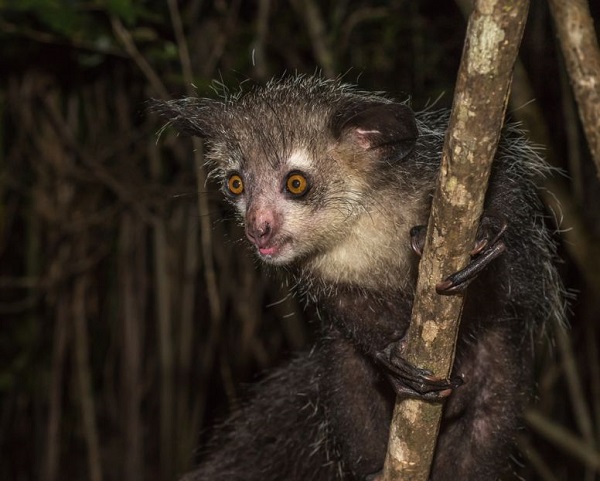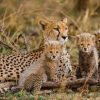
The Aye-aye is a rare lemur that is native to Madagascar. They are the world’s largest nocturnal primate that is characterized by its slightly bizarre characteristics.
The characteristics include their rodent-like teeth that grow perpetually, and a special middle finger that is long, thin and almost skeletal in appearance. They are also known for their highly unusual feeding ritual called ‘percussive foraging‘.
Aye-aye are found primarily in rainforests or deciduous forest land, although some have adapted to live in cultivated regions that resulted from deforestation. They spend the majority of their life high up in trees, close to the canopy.
The aye-aye is currently classified as endangered, due to habitat loss of their forests and because locals consider them as ‘evil’ and often kill them if they come across them. A second species, Daubentonia robusta, became extinct sometime in the last century.
Below are 10 unusual facts about Aye-Aye.
1. The Aye-aye is one of only two animal species that hunts for food using ‘percussive foraging’ – the method of tapping and making a hole in a tree to find prey. They tap on trees up to 8 times a second and will spend between 5 and 41 per cent of their foraging time tapping and gnawing on wood to make holes to catch their prey.
2. Their bizarre, long and multi-purpose middle finger is being used for tapping wood, & foraging edibles. The third finger on each hand of the aye-aye is thinner than the rest of them as they are used for tapping and digging while foraging for food.
The middle finger also has a ball and socket joint, which allows it complete 360 degree movement, to enable it to reach into little holes and pull out grubs.
3. Aye-ayes have unusual coloring that changes as they age. When young, the Aye-aye has a silver front and a stripe down the back. When they reach maturity, the body is completely covered in a thick fur, but not one of a single color. The head and back will have white tips, and the ends and the rest of the body are brown, yellowish and or black.
4. They pick their nose, their special extended finger is not only useful for foraging grubs, aye-ayes have also been caught on video using it to pick their nose – and eat their mucus!
Their finger can be 8cm long, and they manage to stick most of it up into their nose. Researchers believe that it goes so far, it ends up in their throat.
5. The Aye-aye is the only primate to use echolocation to find its prey. When they tap trees, they use echolocation motions to find cavities and detect the vibrations and movements of insect larvae moving within the cavities.
The ridges on the inside of their ears act like a lens, allowing them to capture more oblique sounds from their tapping and prey movements.
6. The Aye-aye is nocturnal, and arboreal. This means that it’s awake at night, and generally spends most of its life in the trees.
While they do find their way down to the ground every so often, they will eat, sleep, travel and mate in the trees. They prefer to spend time near the canopy where there is much more cover.
7. Aye-ayes nest in trees during the day. During the day, Aye-aye sleep. They have spherical nests that are located in the forks of trees and are made out of branches, vines and leaves.
8. The Aye-Aye male has a personal territory that it will mark with a scent. The home ranges (or territories) of males can overlap and males can be somewhat social with each other.
The female habitats never overlap although a male territory can overlap that of more than one female. The male’s territory can advance to 80 acres in size while the female territory is not much more than 20 acres.
9. Female Aye-ayes are dominant to males. They are not known to be monogamous, either. It is not uncommon for females to challenge one another for a mate.
When mating, the male is typically locked to the female and mating sessions can last up to an hour. Aside from mating, males and females may interact when foraging.
10. The Aye-aye was thought to be extinct in 1933. But it was rediscovered in 1957. Since then, their numbers have been only estimates. In 1992, the IUCN estimated the total population to be between 1,000 and 10,000 individuals



